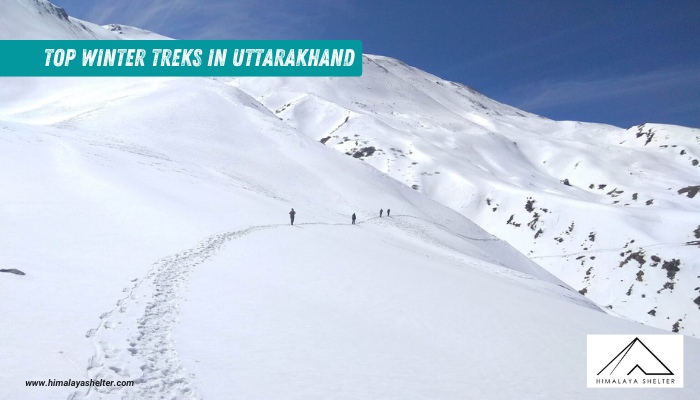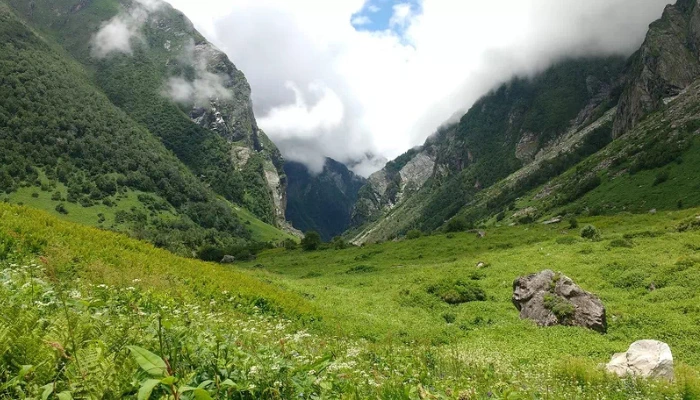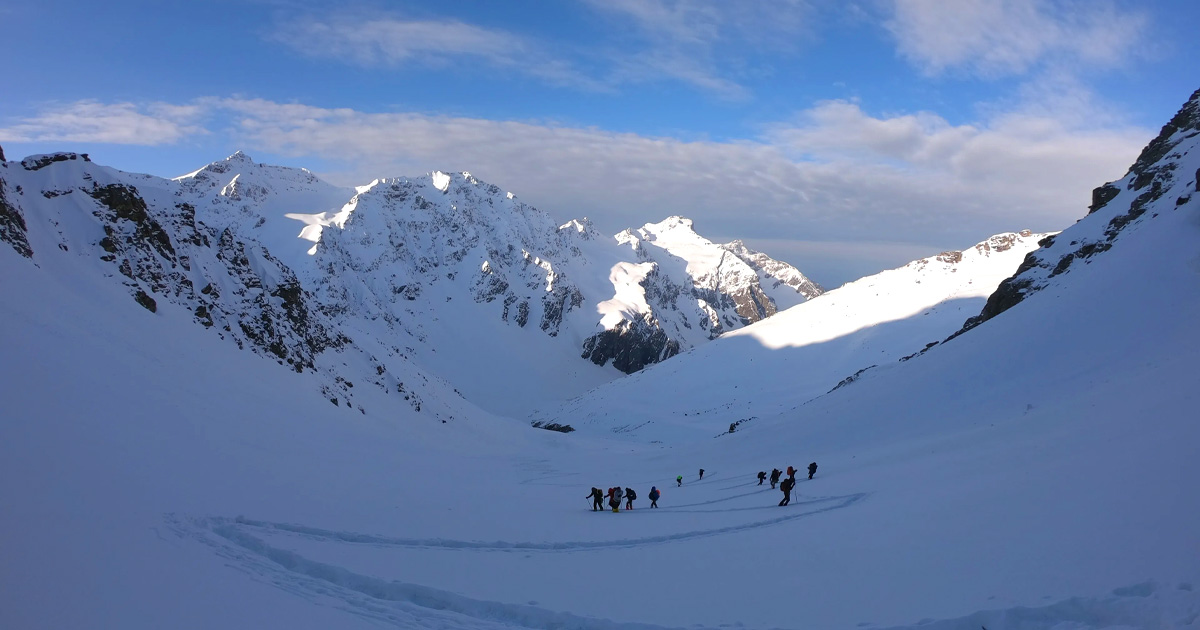
Buran Ghati Trek
TREK DIFFICULTY
Moderate - Difficult
TREK DURATION
7 Days
HIGHEST ALTITUDE
15,000 feet (4,572 meters)
GROUP SIZE
12
TREK DISTANCE
38 Km
BASECAMP
Himachal Pradesh
BEST TIME
May to June | September to October
PICKUP POINT
Himachal Pradesh
Buran Ghati Trek Overview
Buran Ghati Trek is one of the best Himalayan treks in India. We can make this simple and tall statement because this trek encompasses every element of a typical mountain landscape – forests, meadows, rivers, lakes, waterfalls and villages. Adding to that is the thrill of an overnight Pass crossing, snow rappelling and snow slides!
This shepherd’s route connects Pabbar valley of Shimla to Baspa valley of Kinnaur. Other two passes in the same mountain range that connect these two valleys are the Guna Pass and Rupin Pass. The Buran valley in fact runs parallel to the Rupin valley. They are separated by just one cliff range.

Best time to do the Buran Ghati trek in the mighty Dhauladhar ranges of Himachal Pradesh is summer or autumn. Rappelling down a vertical snow wall and sliding in snow is possible in the summer months of April-June. In the autumn months of September-October, the ice has melted and the Pass is descended over a slightly tricky stone trail. Both the seasons have contrasting but equally beautiful landscapes. In other months, the weather is too hostile to trek.
We will arrange for your transport from Shimla to Janglik. Your trek begins from this village with greetings from Himachali mountain folks. You cross pine forests to reach Dayara – a sprawling meadow with galloping horses. At Litham, you camp between the river Pabbar and a waterfall. You make an excursion to the source of these two water bodies – Chandranaahan Lake – which is said to be sacred. You proceed to the high-altitude campsite of Dhunda, situated at the foot of Buran Pass. After crossing Buran Pass, also known as Barua Pass, you rest at Munirang or River Campsite. You then descend to Barua village and its farms of peaches, apples, apricots and jeera and return to Shimla.
It is easy to reach Shimla from Delhi or Chandigarh through regular local buses. Or you can take a train from Chandigarh to Kalka, which is the nearest station to Shimla. Being a challenging trek in the Indian Himalayas, Buran Ghati is recommended for people who have done at least one multi-day Himalayan trek.
Difficulty Level of the Buran Ghati Trek
Trekking in Buran Ghati is rated moderate to difficult. The highest point of the trek is 4,550 m and the trail is around 38 km long, passing through diverse terrains. The trek takes one week (7-8 days) to complete. It is suitable for trekkers who have some high-altitude trekking experience or prior trekking experience in Himachal Pradesh.
Trek starts in the lush green meadows and pine, oak and rhododendron forests of Janglik which also serves as basecamp. Slowly it transitions into alpine zones with wildflowers, snow bridges, stream crossings, high-altitude lakes and rocky sections. The trail also includes long ascents and steep descents, especially steep descents that require technical help of ropes, harnesses and ice axes – certainly not suitable for solo trekkers. A 70-degree snow wall descent just after the pass is the most challenging part and requires experienced guides and technical support.
Trekkers face rapid altitude gain while trekking in Buran Ghati which often triggers AMS. Proper acclimatization and hydration are mandatory. Trekking requires 7-8 days to complete hence carrying a loaded backpack with all trekking essentials is imperative.
Buran Ghati trek is not suitable for kids, family and beginners. Also, it requires physical fitness, mental strength and optimal training. Trekkers also must be prepared for sudden weather changes and Himalayan risks.
.
Day-by-day breakdown of the trek:
- Day 1: Shimla to Janglik (9,415 ft)
Drive approx 160 km from Shimla to Janglik (basecamp), passing through Rohru and Chirgaon. Path offers scenic views of the Pabbar River and traditional Himachali villages
- Day 2: Janglik to Dayara Thatch (11,115 ft)
Trek 6–7 km through pine and oak forests to reach the meadows of Dayara Thatch, a campsite surrounded by towering peaks.
- Day 3: Dayara Thatch to Litham (11,800 ft)
A 4–5 km trek through open grasslands and streams leads to Litham and offers a panoramic views of the Dhauladhar range.
- Day 4: Acclimatisation Day – Visit Chandarnahan Lake (13,200 ft)
Undertake a 6 km round trip to the glacial Chandranahan Lake. This acclimatization hike helps prepare for higher altitudes ahead.
- Day 5: Litham to Dhunda (13,100 ft)
Trek 4–5 km to Dhunda, a campsite located amidst snow-clad mountains and serves as the base for the Buran Pass ascent.
- Day 6: Dhunda to Munirang via Buran Ghati Pass (15,000 ft)
The most challenging one. It covers approx 8 km. Ascend to the Buran Pass, then descend steeply to Munirang (11,100 ft). The descent may involve rappelling down a snow wall, needs technical help or rope and harness.
- Day 7: Munirang to Barua Village and Drive to Shimla
A 5–6 km trek through apple orchards and traditional villages leads to Barua. From here, drive back to Shimla.
In Himalaya Shelter, we provide you with the option to customize your Buran Ghati trekking experience. Whether you're a beginner, solo traveller or a group of friends, you can opt for our personalized tailor-made trekking program. This customized trek will be exclusively designed for you, taking into account your specific requirements for transportation, accommodation, meals and any other premium facilities you may need during the trek.
Starting from Janglik village, the trail of Buran Ghati passes through the variety of terrains including forest, meadows, glaciers, streams and rivers crossing and rocky sections. Himalaya Shelter ensures your journey is safe and memorable with experienced local guides and all necessary permits. You can even request offbeat routes or sunrise hikes for a more immersive Himalayan experience.
Moreover, no other participants will be added to your group. Choosing a customized trek will enable you to fully enjoy the trek with your loved ones.
Located in Pabbar Valley of Himachal Pradesh, Buran Ghati Trek is known for its natural beauty and spiritual significance. The region is dedicated to Shaivism and other Himalayan deities. Some nearby villages like Janglik and Barua were believed to have divine protectors (gram devtas) and worshipped by Himalayan tribes. Mythologically it is said that a sage once discovered the 'Buran' (Gateway of Winds) here and named the pass after it.
During the medieval period, Buran Ghati region came under the influence of Rajput chieftains and Bushahr State (a regal state based in Rampur). Then, it was used as a transit pass for trading of wool, salt and herbs among the different valleys. It connected the Pabbar Valley with the Baspa Valley in Kinnaur. Buran Ghati was called as a 'secret path' to avoid taxation during inter-clan conflicts. It was also used by the Gaddi community to move their livestock between high-altitude summer and low-altitude winter meadows.
In the British period, the British recognized the strategic importance of Buran Ghati for navigating and potential escape routes. However, they had limited direct control over the high passes like Buran Ghati. Some British officers have mentioned their journeys to Chini (Kalpa) or Rohru in their travelogues. An old British forest officer has mentioned 'mysterious trail above Barua', possibly refers to Barua Ghati and the surrounding region.
After independence, Buran Ghati remained a hidden gem for a long time. But in recent decades, it was rediscovered by some trekking communities and got recognized for its dramatic ice wall descent and different terrains. Janglik village, which served as a basecamp to Buran Ghati trek, is known for its preserved wooden Himachali architecture.
- Diverse Terrain: Buran Ghati trek has a variety of terrains- you will cross different types of terrains with passing of each destination. Trek starts with the lush green forests of pine, oak and rhododendron and then it opens into the wide spread meadows like Dayara Thatch. Treks pass by glacial lakes and snowfields and move to dramatic mountain passes. The continuous changes of trek appear visually appealing and physically engaging.
- Stunning Views: Throughout the trek, your eyes are treated with the magical views of the Dhauladhar and Kinnaur ranges. Campsites like Dhunda, Janglik and Litham offer stunning sunrise and sunset views with golden hues. It makes snowy peaks turn golden and pink. On the Barua sides it seems very spectacular with wide beautiful valleys. For photography lovers, it's a pure delight.
- Adventure Elements: Trekking in Buran Ghati Pass is full of adventure. It involves true Himalayan challenges as steam crossings, glacial zones, rapid altitude gain and a rope-assisted descent. Here you will find snow in the summer season. These challenges with breathtaking visuals make trekking more exciting and thrilling.
- Chandranahan Lake: Chandranahan Lake is a cluster of small ponds fed by snowmelt. It is located at an altitude of 4,200 m. To reach here, you need a hike from Litham over uneven, rocky and often snow-covered terrain. The lake is considered sacred by the locals. In the contrast of snowy ridges, the setting of Chandarnahan Lake seems isolated and stark which gives mystical vibes.
- Buran Ghati Pass: This is the highest point of the trek (4,572 m) and the most thrilling part of the trekking in Buran Ghati. To reach the pass, you have to make a steep ascent which is often through snow. But the real adventure starts while descending- it requires technical rope support and sometimes help of ice axes. Trekkers slide down with the help of experienced guides. It offers a full-blown expedition feel with thrilling adventures.
To reach the Buran Ghati trek, reach Shimla (Himachal Pradesh) first. You can reach Shimla directly from Delhi and Chandigarh.
- By Road: From Delhi or Chandigarh, take an overnight Volvo or HRTC bus (8-9 hrs) to Shimla. From Chandigarh it takes 4-5 hrs to reach Shimla by bus.
- By Air: From Delhi, there are limited flights to Shimla (Jubbarhatti Airport). However, from Chandigarh, there are no direct flights to Shimla. You can opt for a taxi or cab which usually takes 4-5 hours to reach.
Shimla to Janglik (Base Camp)
From Shimla, take a taxi (mostly shared) to Janglik village. It is around a 160 km journey and takes approx 9-10 hrs to reach.
Start trek from Janglik
From Janglik, the trek to Buran Ghati gets started. It passes through Dayara Thatch, Litham, Chandranahan Lake, Dhunda, Buran Ghati Pass and concludes at Barua village.
Return from Barua to Shimla
From Barua, there are very limited public transports available to Shimla. You can arrange a taxi back to Shimla. Usually trek organizing companies arrange this service.
- Additional Tips
- Stay in Shimla a day before trek for acclimatization.
- Carry valid ID proofs.
- Ensure physical and mental preparedness as trek can be somewhat challenging.
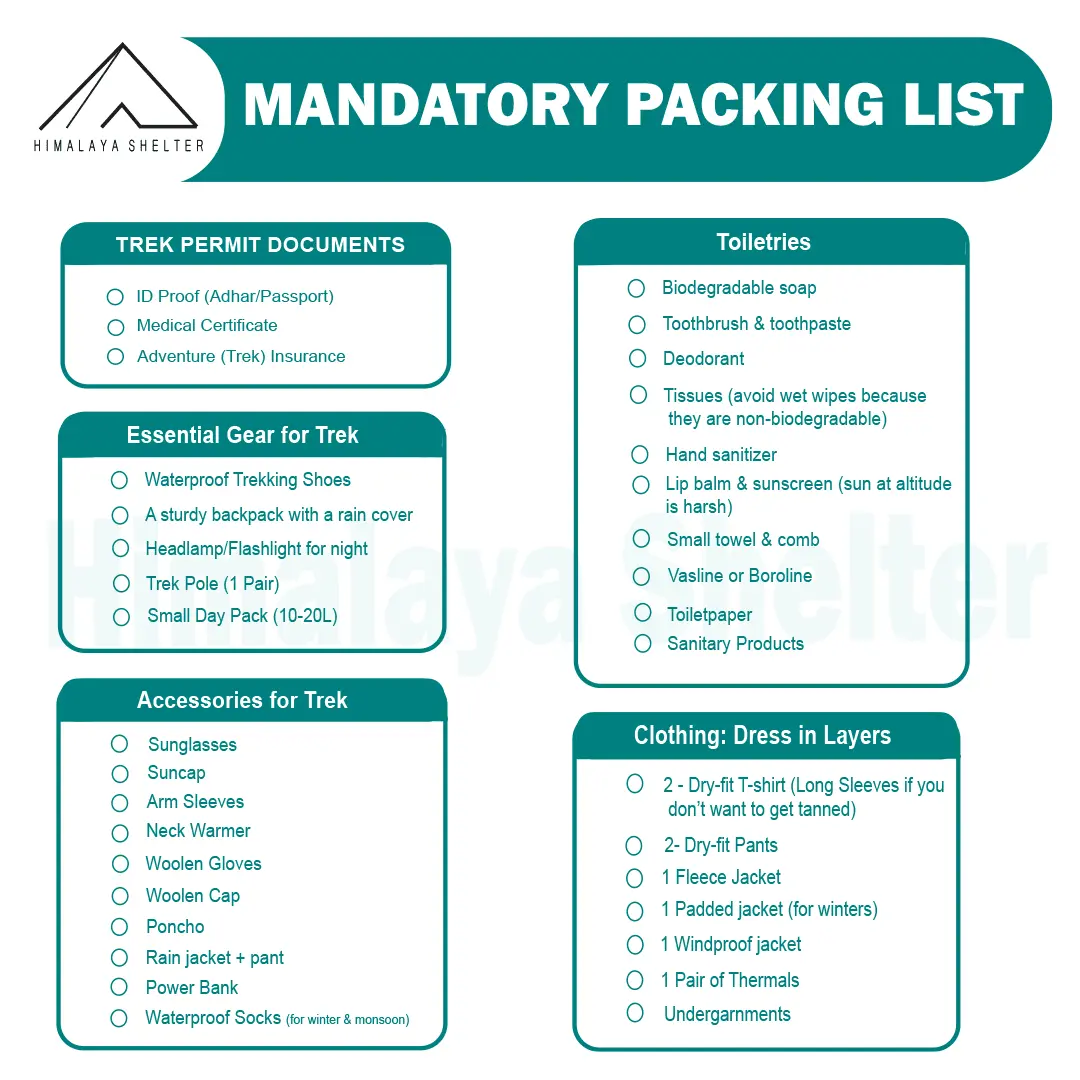
Notice: All trekkers are strictly advised not to carry unnecessary plastic items such as disposable bottles, single-use cutlery, polythene bags, and food wrappers during the trek. We encourage the use of reusable bottles, tiffin boxes, and cloth bags to minimise waste and protect the fragile Himalayan ecosystem. Your cooperation is essential in ensuring a clean and sustainable trekking experience
Physical Fitness Preparation for Trek:
To overcome the difficulty level of Bali pass trekking, it requires strong cardiovascular endurance, muscular strength, and overall physical fitness. Incorporate these exercises into your routine to increase strength, stability, and stamina, which will help you tackle difficult terrain sections of the trail at high altitudes.
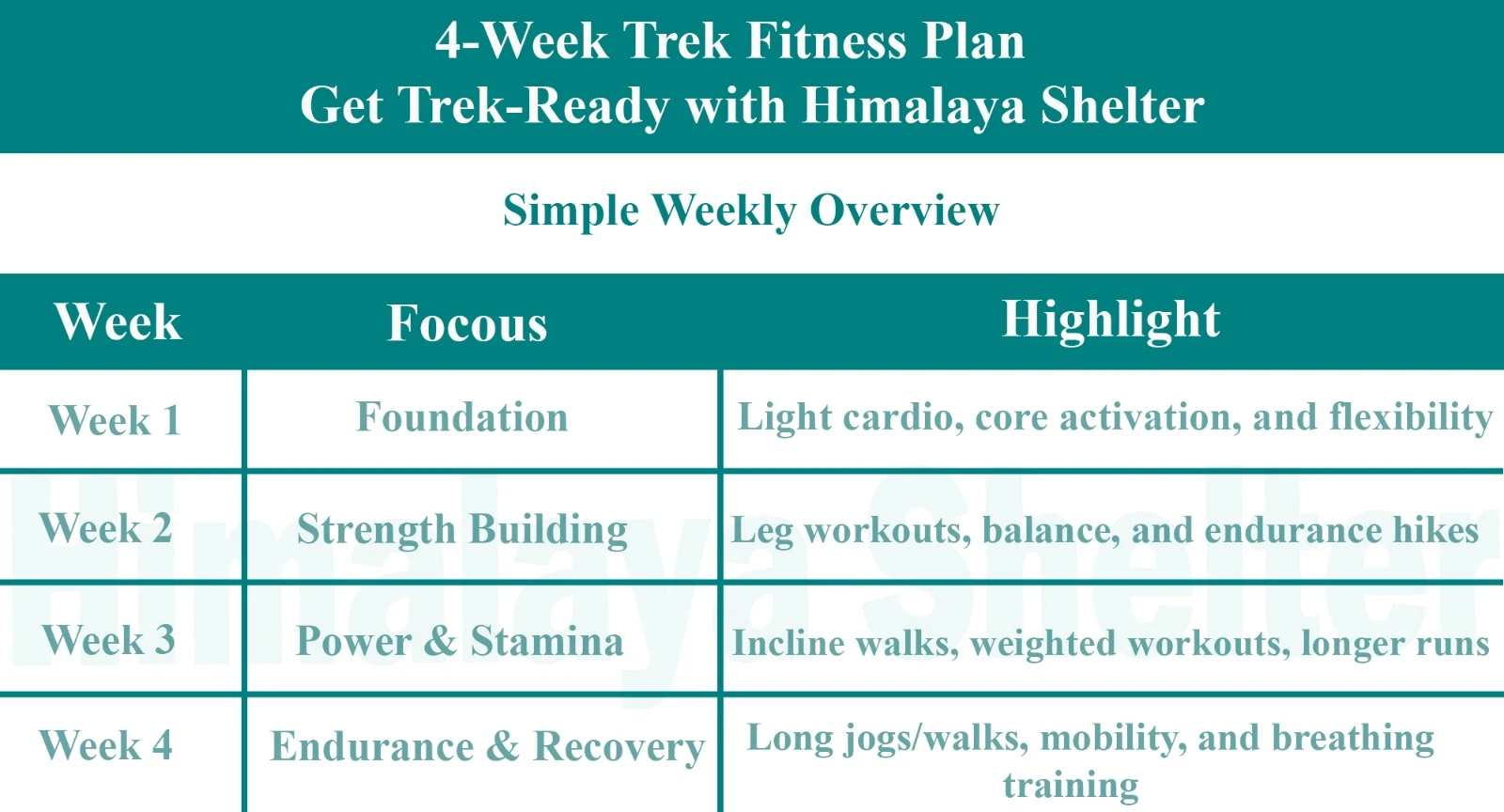
Overview
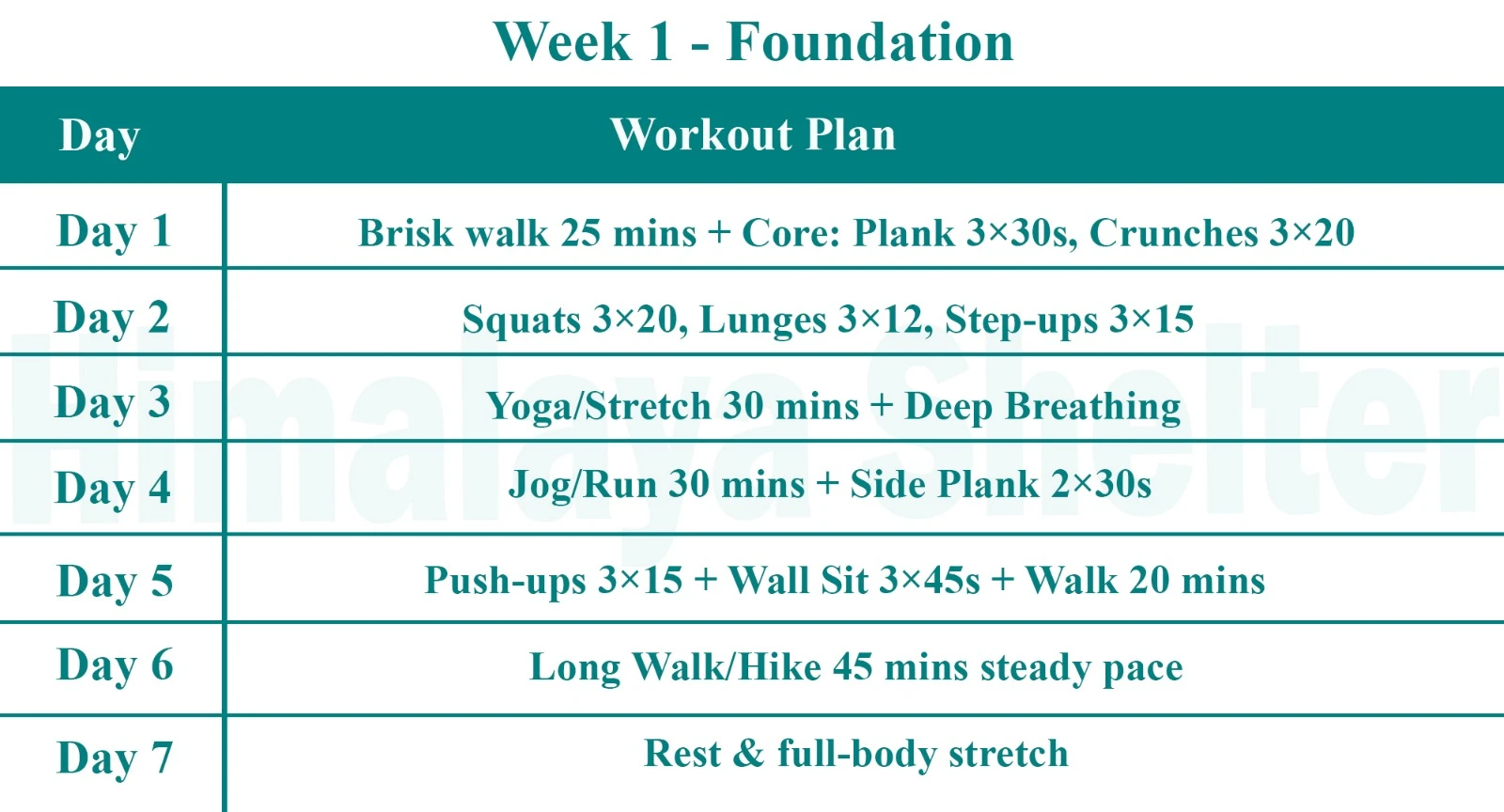
Foundation
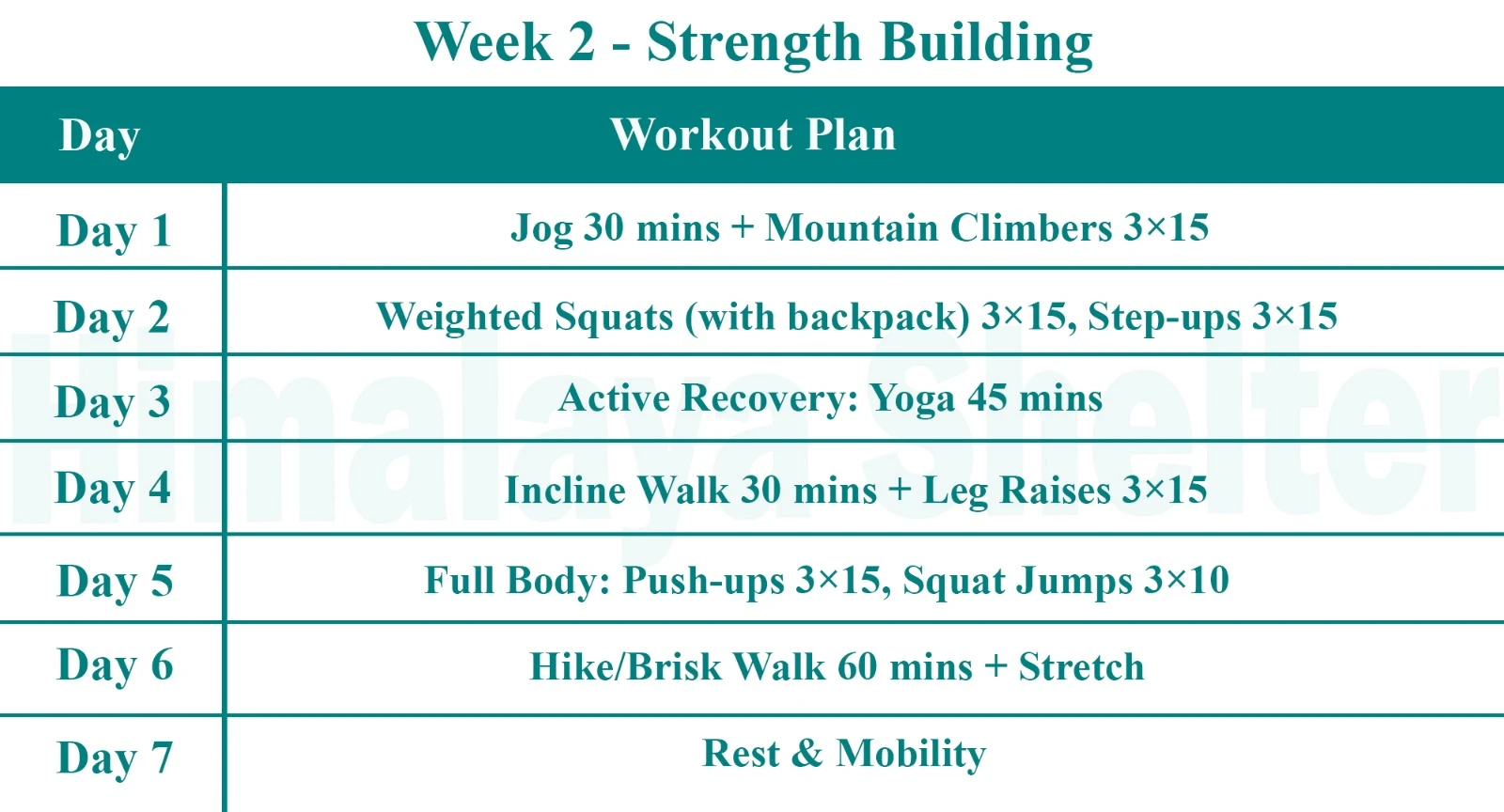
Strength Building
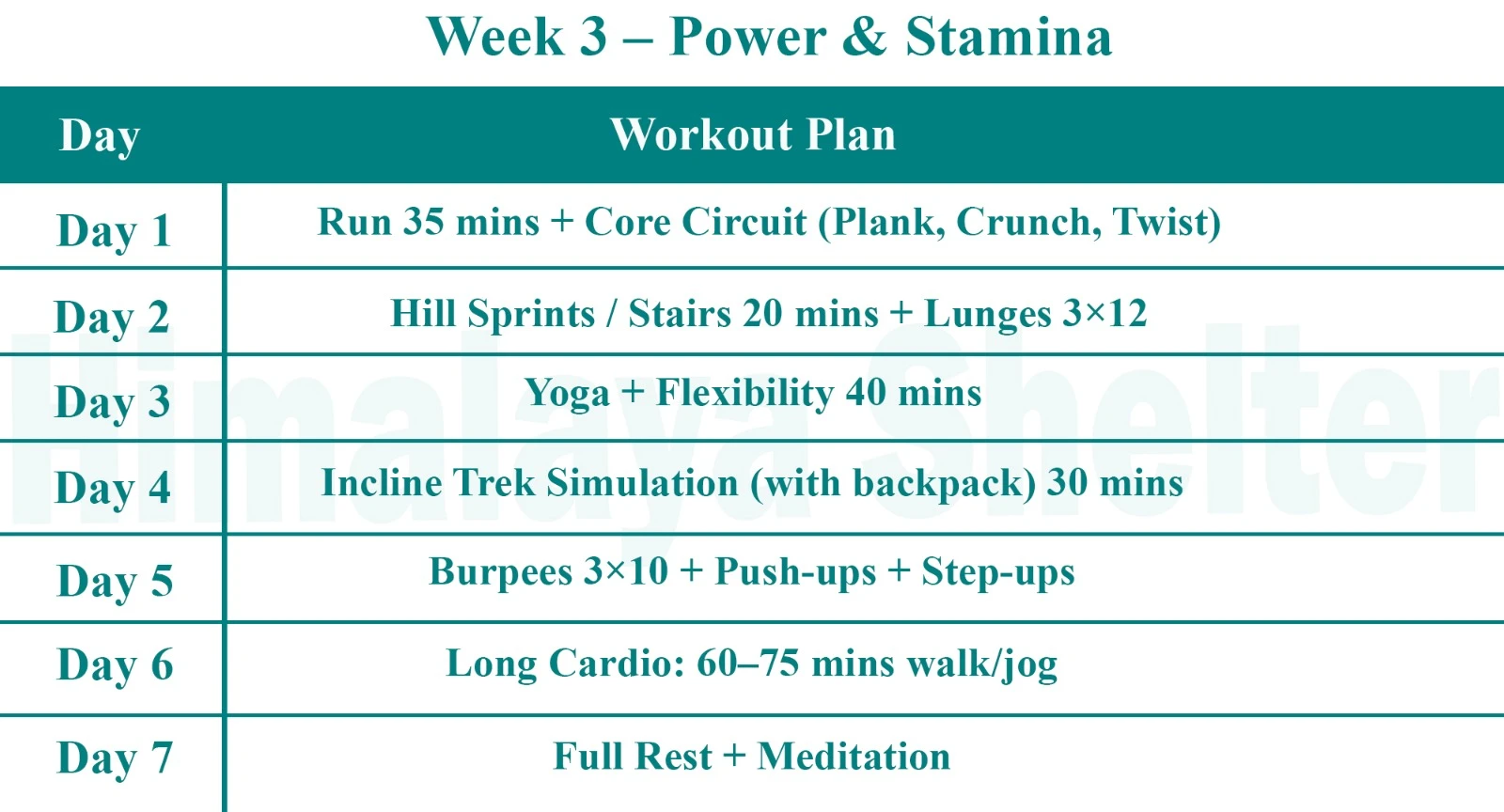
Power & Stamina
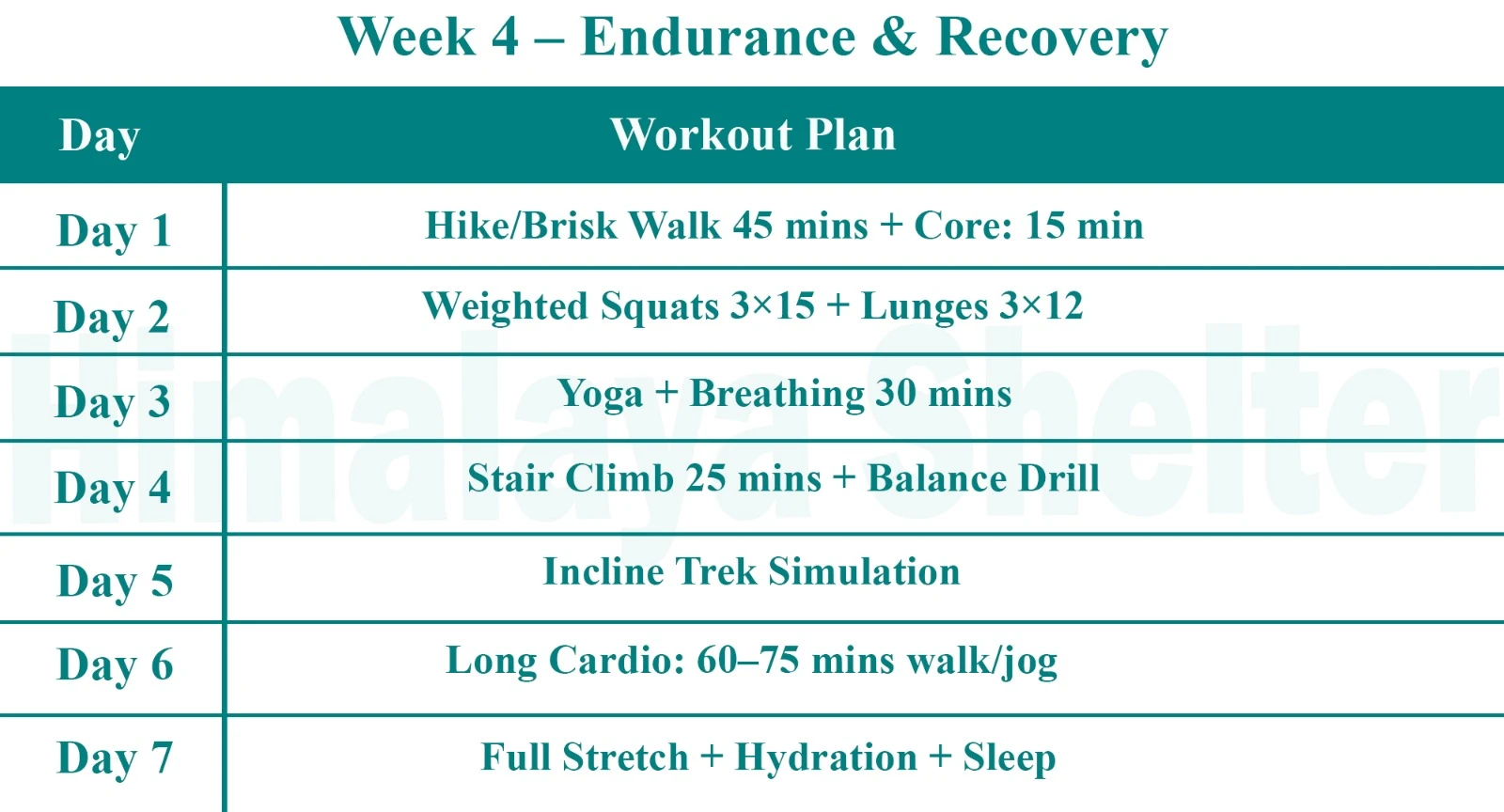
Endurance & Recovery
Buran Ghati is a trek that caters to all tastes and temperaments. Here’s laying out the seasonal menus, so you can pick what you relish.
- May

Lo and behold sheets of snow to trudge through, roll in, slide over, climb on and also rappel down.
Yes, we mean that all. Buran Ghati is a snow enthusiast’s must do trek in this month, for its snow-scape is versatile and serves as a massive playground of sorts.
One of the play activities is climbing up a steep snow hill, at 2:30am, under the twinkling stars and glowing moon, to reach the Buran Pass. (You read that right).
Standing on the Buran Pass, witness the surreal view of a valley that has just woken up and is beckoning you with swirling mist. You can reach the valley only by rappelling down the ice wall on the other side of the snow hill.
Adventure doesn’t end just there. You then have numerous snow slides to propel you towards your next campsite as you gleefully squeal “wheeeee”.
Don't forget to look over your shoulder once in a while as you climb the snow hill to reach the Pass, to witness one of the most mesmerizing daybreaks
- June
During this month, you still have that magnanimous snow playground offering all the above activities, including the rappelling and slides.
But the snow has thawed substantially and also made way for a seemingly endless carpet of green grass, embroidered with yellow, purple and white flowers.
June is the perfect month to witness the best of both worlds. Sprawling grasslands of the meadows, traversed by adorable sheep and horses, make way for ever-growing snow fields as you head towards the Pass.
- Sep - Oct
In these months, the snow has bowed out. The long-standing ice wall too has melted away to rest awhile. The Pass can now be crossed over during normal working hours by walking down a slightly tricky stone trail, instead of rappelling.
What you might miss of the snow is compensated by the magnificent grasslands of this season, though. After the monsoons, they have now become an even more charming and invigorating shade of lush green. The flowers too are even more animated and causing a riot of colours, standing out against autumn’s green pastures and brown mountains.
For those who would much rather soak in bright, lively hues of a colourful land instead of a sea of white snow, these are the months to be at Buran Ghati.
The Buran Ghati trek is a wholesome trek, with the varied seasons simply offering different flavours. And all of them are lip-smacking.
Did we help you by chalking out which season best suits your taste and temperament palette, or maybe even tempt you to try out a new cuisine, let us know by commenting below.
Day 1: Shimla to Diude/Janglik: 150 KM Drive in 7 to 8 hours
The base camp of Buran Ghati is Janglik, located approximately 150km from Shimla. It as an old Himalayan village with limited Airtel network.
The road from Shimla to Janglik is scenic with its winding roads, wheat fields, Himachali houses. The flowing Pabbar river joins you at Rohru. Rohru is the last place where you can find an ATM.
Just after Chirgaon, you take a left turn to climb a dirt track. Two hours later you reach Tangnu and its pine forests. Driving past a police check post and a broken bridge, the car will drop you at Diude. The walk to Janglik from Diude is short.
Day 2: Diude/Janglik (9,200 ft) to Dayara (11,075 ft): Trek in 5 to 6 hours
You get to witness Himachali wooden architecture as you pass through the village. The houses made of Deodar wood have artistic carvings and fascinating roofs. Within 15 minutes, you will leave the village behind.
You will find yourself on a steep trail that leads to an oak and pine forest. The path with will become gradual as you go deeper into the woods.
The trees clear unexpectedly to reveal the massive expanse of Dayara. Your heart will be filled with delight on seeing a vast, undulating green meadow with thousands of yellow wildflowers.
The meadow has small hills on one side a gorge on the other. In the middle, you will see horses galloping with abandon among herds of sheep. Spend the evening with local Himalayan shepherds. They will speak to you humorously of a difficult but content life in the mountains.
Day 3: Dayara (11,075 ft) to Litham (11,737 ft): Trek in 3 hours
We recommend waking up early to witness the sunrise too. The interplay of yellow rays and grey shadows over a large carpet of grass will leave you mesmerized. If you thought you had seen all that you possibly could of meadows, you are wrong. Today you will walk across meadow after meadow with forests interspersed between them. The first forest you will cross is again of pine, followed by silver birch i.e. bhoj. The bark of the bhoj tree was used as paper in ancient times.
The trail from Dayara to Litham is almost a gentle descent throughout with multiple streams along the way. You will see Guna Pass among the now visible snow-capped Dhauladhar range. Once you hop over the Chandranahan stream, you reach the Litham campsite. Litham too has a charm at par with Dayara. To your front are the cliffs that hide Buran Pass. On your left you can see the mouth of the Chandranahan waterfall. On your right is the Pabbar river, musically flowing before the mountain range that hides the Rupin valley.
You get to spend two days at this scenic campsite, since one day is an excursion to Chandranahan lake.
Day 4: Excursion to Chandranahan Lake (13,900 ft): Trek in 4 to 5 hours
Today you visit Chandranahan lake – the source of the river you are camping by and drive along on your way to Janglik. The lake is considered sacred because as per mythology, the moon on Lord Shiva’s head took a dip in this lake. Hence the name.
You begin the day early to get back to Litham by lunch time. It will be a strenuous day because of a steep ascent and descent. But the landscape you witness is worth the effort.
You cross the stream you hopped over on the way to Litham and make our way towards the waterfall. A shepherd’s trail will take you to ridge top. The waterfall’s snout is marked by charmingly set-up stone cairns. The lake is another hour’s walk on snow patches from here.
Chandrahan is a glacial lake perennially fed by snow. It remains frozen for most part of the year. Though the lake is small, it’s bowl-like setting between flanking mountains against a blue sky makes its size irrelevant.
Day 5: Litham (11,737 ft) to Dhunda (13,365 ft): Trek in 4 to 5 hours
Litham is the last meadow on this trek. You now make your way to the alpine high-altitude campsite of Dhunda. The green grass will give way to grey rocks and patches of ice.
The Dhauladhar range continues accompanying you over a well-marked trail, as does the Pabbar. But the river is flowing much faster now. As you walk along its left bank, you reach a U-shaped gorge-like valley. Here, you finally see Buran Ghati for the first time on your left.
Dhunda at 13,300 feet is set against the feet of the Pass. Unlike your first colourful campsites, this one is surrounded completely by snow during summer. The altitude and the anticipation of the Pass crossing will fill you with excitement.
Day 6: Dhunda (13,365 ft) to River campsite (11,800 ft) via Buran Ghati (15,000 ft): Trek in 9 to 10 hours
Today you will trek for almost 10 hours which will be both ascending and descending. In the absence of snow during autumn, the Pass is not difficult to time. In summer, you begin the climb to the Pass a little after midnight. This is because snow softens during the day, making it difficult to walk.
From the narrow ledge at the top of Buran Pass at 15,000 feet, you get a panoramic view of the Kinner-Kailash peaks. Snow-covered mountains at day-break among swirling mist is a sight that will remain with you for the rest of your life.
You will rappel down the first 100 metres of an almost vertical snow wall into the Kinnaur valley. After that, there are 4-5 patches of snow over which you can just slide down!
The descent from Buran Ghati is very quick, with you losing 3,000 feet of altitude in just 2 hours. Once out of the snow line, you will once again be greeted by flowers and shrubs.
Day 7: River campsite (11,800 ft) to Barua (6,700 ft): Trek in 7 hours
The last day of the trek is a full descent. You will walk through receding trees that give way to diverse Himalayan vegetation. After an hour and a half, you will reach a bridge crossing over a large stream. Soon you will spot trees of apricot, pears and peaches.
An hour later, you will see apple orchards and civilization. You would have entered Barua village through an arch. You will smile at villagers going about their usual day of farming or tending to cattle. Some of them might strike up a conversation and invite you for a cup of tea.
From the heart of the village, the descent becomes even more rapid. Within half an hour you reach the road bridge over Barua Khud. We will arrange for your transport from Barua to Shimla. You will leave by 1pm and reach Shimla by around 10:30pm.
If you want to travel on your own, you can get a vehicle to Karcham junction which is 3km ahead. From this junction you can go either to Rekong Peo or Sangla. Sangla which is 17km away from Karcham is the largest village in the Baspa valley. In fact, Baspa Valley is also called Sangla valley. You could visit attractions close to Sangla like Kamru, Chansu, Basteri, Rakcham, Chitkul village and Ranikanda meadows. Or you can make your way back to Shimla, the most loved hill station in India with its colonial buildings, rhododendrons, oaks and firs.
Our treks are specially designed by the experienced team at Himalaya Shelter, taking you on an adventure of a lifetime all while making you connect not only with the bountiful nature but also with yourself and with others on the trek with you, creating wonderful memories which will last you a lifetime. All Himalaya Shelter treks are guided by experienced Trekkers having vast knowledge and experience of the region, providing with insightful information and stories pertaining to the region’s flora and fauna and the history of the region whilst the trek. It is safe to say that on successfully completing the trek, one will gain tremendous insight and experience along with lifetime memories.
Inclusions
- Transport Support from Shimla on Day 1 to Janglik at an additional cost of INR 1,500 per person and transport support from Barua Village to Shimla at an additional cost of INR 2,200 per person
- Accommodation – At Base Camp, stay at a local homestay or guest house for one night each, which will give you an insight into the authentic lifestyle of the locals.( INR 5000 per person extra for single sharing throughout the trek )
On Trek stay in a 2-person Vango Halo Pro/A-Shape tent, which is to be shared by two trekkers, built to withstand extreme weather conditions and at the same time making you comfortable after a hard day’s trek. - Camping Equipment – specially designed sleeping bags that can withstand harsh weather conditions, foam mattresses. Other safety gear like microspikes, gaiters, an ice axe, and helmets will be provided.
- Medical Kit – our team will be equipped with an extensive medical kit, which our team is trained and experienced to use. Oxygen cylinders are used after they are thoroughly inspected throughout the Trek. Even campsites have large oxygen cylinders as backups.
- Permission - Forest entry charges for Indian nationals (Additional charges will be applicable for international tourists)
- Meals – Breakfast, packed lunch (on trek days), evening snacks, and dinner will be served. A hearty, delicious, and nutrition-filled Veg meals with egg preparation will be provided throughout the trek. (Jain and Vegan Food can also be arranged on prior notification.)There will be a dedicated Kitchen Tent along with a dining tent, which will have a dining table too.
- Our Team – A highly experienced and AMC-certified Trek Leader who will help ensure that the entire trek goes smoothly and safely while navigating the challenging conditions during the trek, and is skilled enough to navigate any medical emergency that can arise during the trek. Local and route Guides who are well-versed with the region and provide an in-depth insight into the local customs and knowledge of the flora and fauna endemic to the region. A dedicated Kitchen staff, which includes a Cook, a helper, and other support staff. There will also be porters and mules to carry common equipment.
- Cloakroom - We have a cloakroom facility available for extra luggage. Every trekker is permitted to leave their luggage behind at no charge.
Exclusions
- Personal expenses like tips, personal medicines, phone calls etc.
- Travel Expenses - Travel expenses from your hometown to the mentioned Pick-Up Point are not included in the trek fee.
From the scheduled pick-up spot to the base camp, we have our own fleet of vehicles like Bolero, Innova, Dezire, or Tempo Traveler (12-seater). This is be shared by trekkers for a pre-decided amount. All vehicles are non-AC. - Personal Equipment - Any personal gear like jackets, shoes, cutlery, or backpacks are not included in the trek fee. We recommend renting them from our Rental Store for an affordable fee. This can be pre-arranged to avoid last-minute hang-ups.
- Offloading - We encourage carrying your backpack to get into the true spirit of trekking. However, if needed, you can opt to offload your personal luggage of up to 12 kgs for an additional cost of INR 500 per bag per day.
- Trek Insurance - A mandatory trek insurance fee is charged in addition to your trek fee. Since most medical insurance doesn’t cover adventure activities, trek insurance offers essential coverage, enhancing your safety without a significant financial burden.
- Buffer day on the trek - We have kept a buffer day on the trek to account for any weather-related delay. If this is utilized, you will need to pay an extra amount to your trek leader.
- Anything apart from inclusions
- Please carry a lunch box for a packed lunch/breakfast to avoid using polythene and Aluminium foil.
Keeping the Himalayas clean is our own responsibility. Reduce the use of Plastic when you are in the abode of the Sacred Himalaya. 🌱
It is a point-to-point trek, usually from Janglik to Barua village.
Yes, especially nea
Is the Buran Ghati trek good for solo trekkers?
r the pass in May and early June.
Not recommended solo unless you are experienced enough. It's remote, challenging and requires technical help.
Dense pine and oak forests, Dayara meadows, Chandranahan Lake, streams and rivers and the dramatic Buran Pass crossing.
Janglik is known for retaining traditional Himachali wooden architecture and rural lifestyle.
Locals believe it is the origin of the Pabbar River and holds spiritual value.
Traditional Himachali festivals like Fagli and Bishu are celebrated in villages like Janglik and Barua.
Yes, respect local customs, avoid loud behavior near holy sites and dress modestly in villages.
Read More on Buran Ghati Trek
Photo Gallery




Treks by Categories
Treks By Month

Treks By Experience






